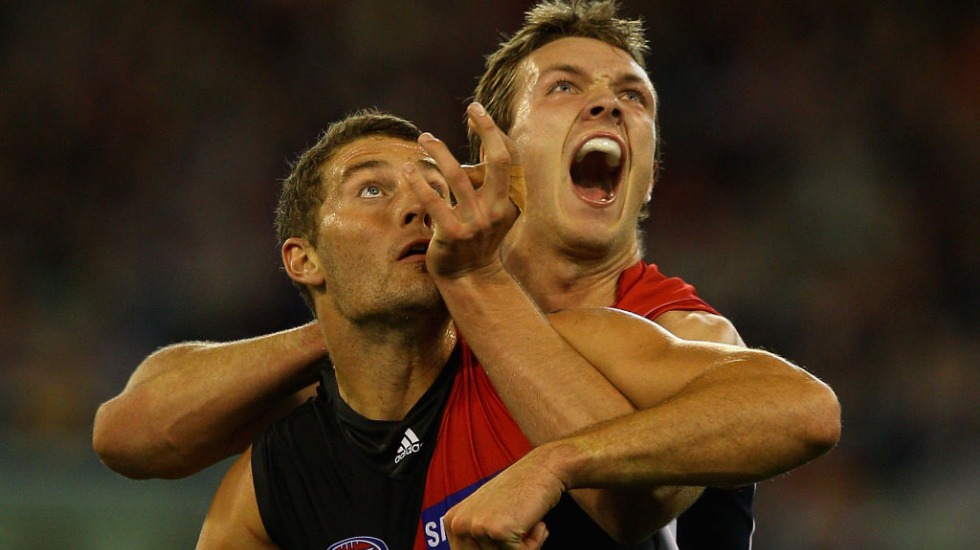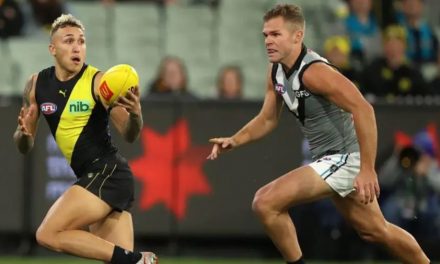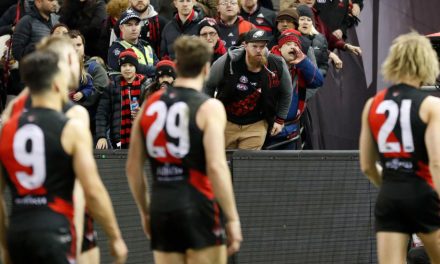A fresh-faced, and beardless, Max Gawn (right) on debut against Essendon’s Tom Bellchambers a decade ago. Photo: GETTY IMAGES
Dennis Cometti’s penchant for the offbeat had already caused comment pre-match, so when the ball was cleared to the wing to the wide open first gamer, he was taking special interest. What’s this kid got?
“Here’s Gawn … on the wing.”
Forty metres clear, the ungainly-looking debutant slowly dropped the ball to his foot. Being 208cm tall does leave a larger window for error and it ended up hitting somewhere closer to his shin.
As it spun in helicopter fashion downfield Cometti left a pause before drawing out his description.
“……ooookaaaay.”
If there ever was a time that the absence of words said so much, it was this.
The context was that Max Gawn’s debut and overall place in the 2011 Melbourne team was seen as a curiosity more than any great dawn. That he might be the bit-part cult figure that Cometti was often drawn to, nothing more.
There was a whiff of an era-defining evening in Round 11 of 2011 when Melbourne took on Essendon on national television under Friday night lights.
Melbourne was expected to rise after an encouraging 2010, but midway through 2011 things were looking average. The week before the Demons had lost badly to Carlton and been slammed for playing ‘bruise-free’ footy, this was a chance to show their wares against fifth-placed Essendon and get themselves back on track.
And that path seemed to be their right, given all the young talent that had been drafted over the previous few years.
The extra sting this night was that the greatest hope of that talent, Tom Scully, was returning for the first game of his sophomore season. Rumours of his departure had been swirling, but surely he’d return to the team, the team would improve and all would be forgotten? Surely.
Scully was named in the team with some fanfare amongst five young players promoted. Two were playing their first AFL matches; Max Gawn and Jeremy Howe.
As Cometti debated with commentators about whether Gawn really stood as tall as his listed 208cm pre-game, in all but a few minds he was an afterthought. Scully had unfairly assumed a heavy burden in his return, but he wasn’t alone. There were supposed saviours everywhere on the field that night in red and blue, but not the big guy.
Scully shone in his first game back. Fellow No.1 pick Jack Watts was influential. Maybe the most assured of them all, Jack Trengrove returned from a three-game suspension with 28 touches.
Jordan Gysberts was to pick up two Brownlow votes and affirm his No.11 draft billing from the year before. Cale Morton had 22 possessions to remind everyone why he had gone at No.4 in 2007.
James Strauss had 20 disposals in his third senior game. Liam Jurrah continued his amazing story with three goals, part of 81 in just 36 games at season’s end.
The five-goal win was reassurance that the Demons indeed had something special, a few weeks later they jumped into the top eight.
On that Friday night Demon fans dared to dream, but Gawn didn’t warrant a second thought apart from a few chuckles at Cometti’s fascination with his height.
The Gawn of 2011 was very different to the 2021 model. He’s not overweight, but he doesn’t look athletic. There is no beard, and there’s a mop of hair. There’s probably been no greater physical transformation of a player inside a decade.
The appearance was partly why there was an air of mirth to what we were seeing, he looked the prototype project player.
Drafted at pick 34, after Melbourne had already spent four blue-chip top-20 picks, he was the loose-change mystery bet on extraordinary height and some deft hands. Project players tend to develop cult followings for a reason though. They end up being defined by their unusual physical stature, not their brilliance. He was a ‘Cometti-ism’ waiting to happen.
In the case of Gawn’s eight possessions and 10 hitouts, it was the most inauspicious of starts. However, the threads of the next 10 years were present both in who was on the field that night, his own contribution and the postscript.
Eight weeks later, after a bunch of yo-yo results of large wins and large losses, Melbourne went to Kardinia Park and lost by 186 points. It was to scar a generation of players and supporters.
Coach Dean Bailey was sacked. Three years later he passed away of cancer, his Melbourne years mired in the tanking allegations that were to come.
PLEASE HELP US CONTINUE TO THRIVE BY BECOMING AN OFFICIAL FOOTYOLOGY PATRON. JUST CLICK THIS LINK.
The jungle drums around Scully were true as he left for GWS just nine games later.
Gysberts faded into obscurity, playing just eight more games.
Morton never reached his draft pedigree and spent a season at West Coast after just 18 more games.
The Jurrah fairytale was to end in its own tragedy and jail time in Alice Springs, he only played one more game after this 40-goal season in 2011.
Strauss (and other forgotten first-round picks like Sam Blease and Luke Tapscott) didn’t reach 50 games with Melbourne.
Howe took his highwire act to a new club where he became a star.
Trengrove’s foot injuries robbed him of speed and confidence, he eked out 61 more games for Melbourne over the next six-and-a-half seasons.
Watts continued on for another six years as the sometime brilliant enigma, but never the player the public thought he should have been.
By 2021 Gawn, Nathan Jones and Neville Jetta were the sole survivors of that night. At the time none of them were seen as the hopes that the above group were – but they have driven the last decade, albeit through unenviable turbulence.
Others involved that night also found their way onto the long road of respectability for the country’s first football club.
Jake Melksham kicked Essendon’s first goal of the game, while Michael Hibberd earned plaudits for his attack on the ball. A winding path with supplement landmines led them to Melbourne to join Gawn, Jones and Jetta in the rebirth. They have played a significant role in Melbourne’s rise.
They’ll be just in, or like Jones and Jetta, just out of a grand final team. The road outrunning most of that group. If they all had access to a crystal ball in Round 11, 2011, they’d have smashed it for being too far-fetched.
The Essendon coaching staff probably didn’t take too much notice of the first gamer wearing Jim Stynes’ original No.37. In the Essendon coaching box, first-year assistant coach Simon Goodwin might not have a had second thought about the big awkward kid on the opposition, either. He’s now a game away from hoisting a cup with him.
Melbourne had opened up a five-goal lead in the third quarter of round 11, 2011 only to see Essendon roar back within two goals early in the last quarter. Melbourne steadied, however, the big kid was to take two marks around the goal square late in the game.
The first one was on an angle and saw Gawn try to snap around the corner, only to hit the post.
The second one was 15 metres out straight in front, but he missed again.
Ten years later and Gawn has completed those two actions with much more success in recent times.
The shot in front to claim top spot after the siren in Geelong, and the running snapped goal of a rollicking individual preliminary final explosion that earned a grand final berth which has a more complicated history than most great moments in the game.
Two ACL injuries, years of career stagnation, team misery, shakiness in front of goal, the sudden rise to ruckman of the generation, morphing from joker to leader, and the sheer unlikeliness of it all based on that first game sit behind what will be career signatures for him.
The degree of difficulty and consequence between these kicks in 2011 and 2021 are starkly different, but the symmetry between game one and the most important six weeks of Gawn’s career are uncanny.
On Saturday he may well be the most pivotal player among two evenly-matched line-ups, meaning that the negating job of the Western Bulldogs’ No.1 ruckman may be what stands between Gawn, Melbourne and end of 57 years heartache.
In round 11, 2011 Gawn was the back-up ruckman who entered the centre square a few times to relieve a promising and seemingly infinitely more athletic young ruckman.
Melbourne’s No.1 ruckman that night? Stefan Martin – Gawn’s opponent next Saturday.
He was the one that kicked the ball to Gawn for his shinned introduction to AFL audiences.
That night was the last gasp of an era that didn’t get out of the starter’s barrier.
But if in the darkest days comes the new dawn, there were a bunch of clues on the MCG that Friday night in June that eventually came together on a scenic route to the 2021 Grand Final.
It’s just that nobody thought the saviour of the Melbourne Football Club would be Max Gawn. Least of all Dennis Cometti.












Really enjoyed that article Shannon, reliving those last 10 years! This week I have been reflective on the many games I have attended only to see the Dees get smashed and absolutely not have their hearts in the game! Those cold evenings on the train from Jolimont to home thinking, this is hard work! But never giving up and now payday has finally come. I shed a tear for Jim Howard and Jim Stynes, and others, who I know would have both loved to see how 2021 panned out! Go Dees!! Denise